Hospitality Business Toolkit Report: Financial and HR
VerifiedAdded on 2023/01/13
|12
|2878
|81
Report
AI Summary
This report provides a comprehensive overview of the hospitality business, focusing on the financial aspects and HR practices of Marriott International and Health and Taste juice center. It begins with an analysis of key financial documents such as the Profit and Loss account, Cash Flow Statement, and Balance Sheet, along with the principles of managing financial performance and double-entry bookkeeping. The report then delves into the HR lifecycle, evaluating stages like recruitment, motivation, evaluation, and celebration, with a project management plan for an Assistant Waiter role. Furthermore, the report discusses specific legislation, including the Minimum Wages Act and the Equality Act, and their impact on decision-making within hospitality organizations. Recommendations are provided throughout the report to improve processes and ensure compliance with legal and financial requirements.
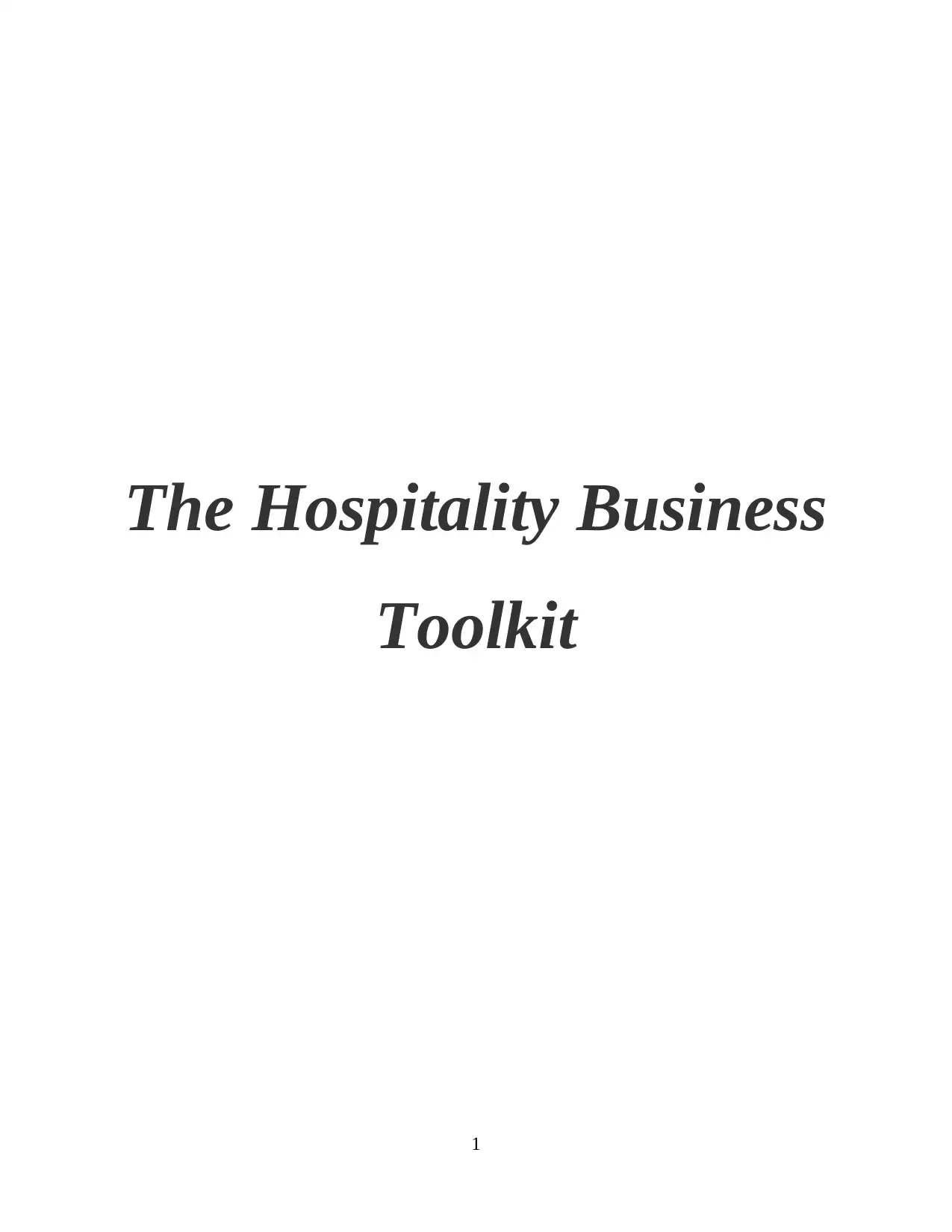
The Hospitality Business
Toolkit
1
Toolkit
1
Paraphrase This Document
Need a fresh take? Get an instant paraphrase of this document with our AI Paraphraser
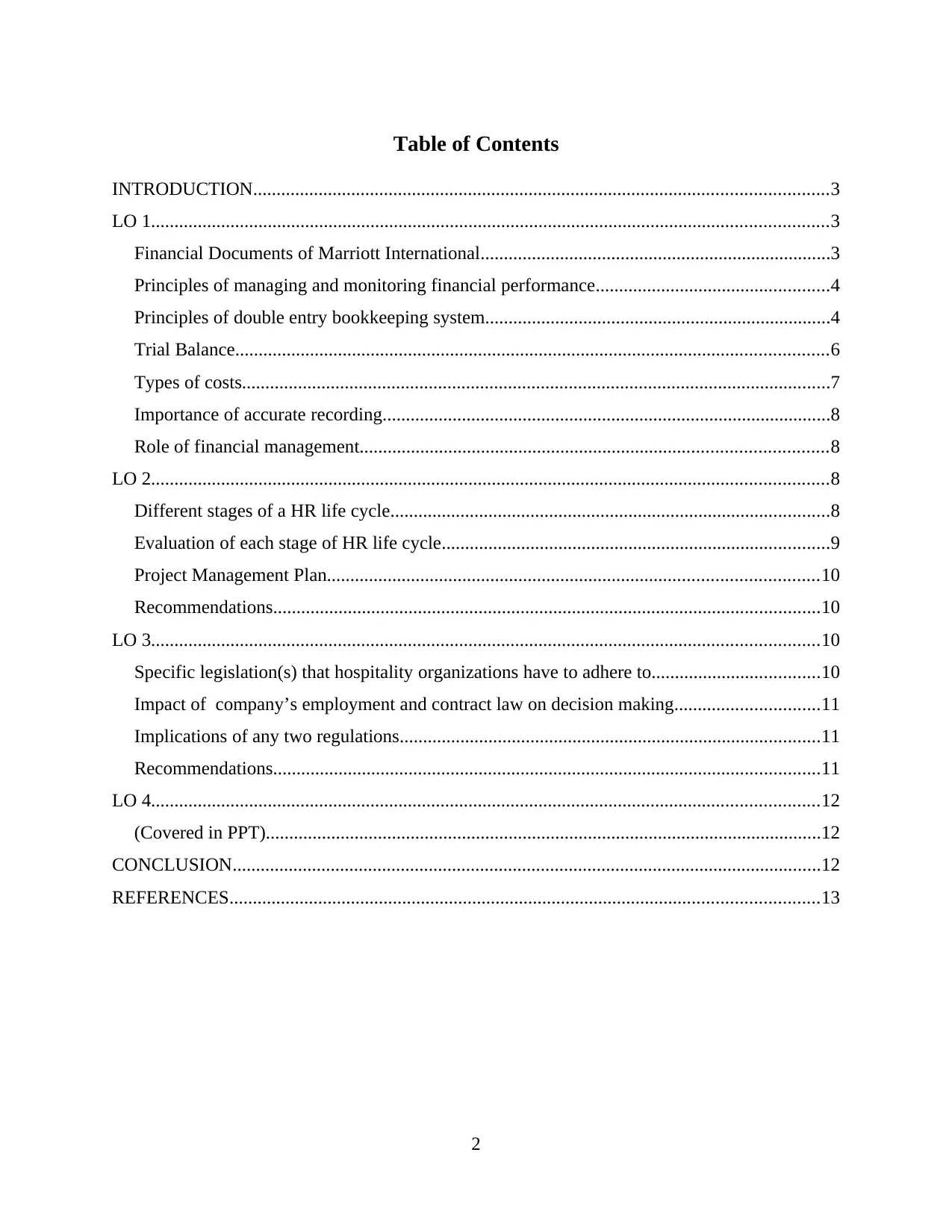
Table of Contents
INTRODUCTION...........................................................................................................................3
LO 1.................................................................................................................................................3
Financial Documents of Marriott International...........................................................................3
Principles of managing and monitoring financial performance..................................................4
Principles of double entry bookkeeping system..........................................................................4
Trial Balance...............................................................................................................................6
Types of costs..............................................................................................................................7
Importance of accurate recording................................................................................................8
Role of financial management....................................................................................................8
LO 2.................................................................................................................................................8
Different stages of a HR life cycle..............................................................................................8
Evaluation of each stage of HR life cycle...................................................................................9
Project Management Plan.........................................................................................................10
Recommendations.....................................................................................................................10
LO 3...............................................................................................................................................10
Specific legislation(s) that hospitality organizations have to adhere to....................................10
Impact of company’s employment and contract law on decision making...............................11
Implications of any two regulations..........................................................................................11
Recommendations.....................................................................................................................11
LO 4...............................................................................................................................................12
(Covered in PPT).......................................................................................................................12
CONCLUSION..............................................................................................................................12
REFERENCES..............................................................................................................................13
2
INTRODUCTION...........................................................................................................................3
LO 1.................................................................................................................................................3
Financial Documents of Marriott International...........................................................................3
Principles of managing and monitoring financial performance..................................................4
Principles of double entry bookkeeping system..........................................................................4
Trial Balance...............................................................................................................................6
Types of costs..............................................................................................................................7
Importance of accurate recording................................................................................................8
Role of financial management....................................................................................................8
LO 2.................................................................................................................................................8
Different stages of a HR life cycle..............................................................................................8
Evaluation of each stage of HR life cycle...................................................................................9
Project Management Plan.........................................................................................................10
Recommendations.....................................................................................................................10
LO 3...............................................................................................................................................10
Specific legislation(s) that hospitality organizations have to adhere to....................................10
Impact of company’s employment and contract law on decision making...............................11
Implications of any two regulations..........................................................................................11
Recommendations.....................................................................................................................11
LO 4...............................................................................................................................................12
(Covered in PPT).......................................................................................................................12
CONCLUSION..............................................................................................................................12
REFERENCES..............................................................................................................................13
2
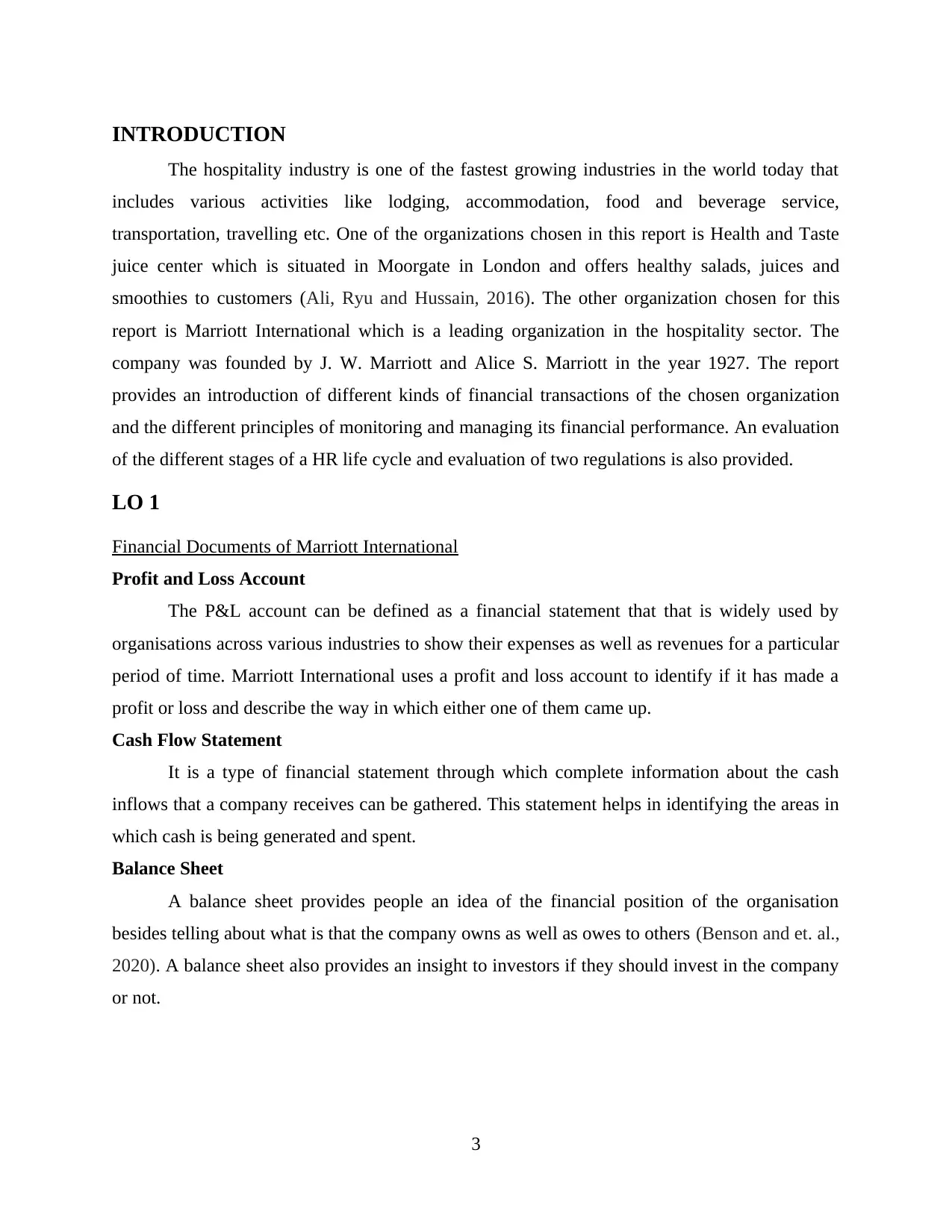
INTRODUCTION
The hospitality industry is one of the fastest growing industries in the world today that
includes various activities like lodging, accommodation, food and beverage service,
transportation, travelling etc. One of the organizations chosen in this report is Health and Taste
juice center which is situated in Moorgate in London and offers healthy salads, juices and
smoothies to customers (Ali, Ryu and Hussain, 2016). The other organization chosen for this
report is Marriott International which is a leading organization in the hospitality sector. The
company was founded by J. W. Marriott and Alice S. Marriott in the year 1927. The report
provides an introduction of different kinds of financial transactions of the chosen organization
and the different principles of monitoring and managing its financial performance. An evaluation
of the different stages of a HR life cycle and evaluation of two regulations is also provided.
LO 1
Financial Documents of Marriott International
Profit and Loss Account
The P&L account can be defined as a financial statement that that is widely used by
organisations across various industries to show their expenses as well as revenues for a particular
period of time. Marriott International uses a profit and loss account to identify if it has made a
profit or loss and describe the way in which either one of them came up.
Cash Flow Statement
It is a type of financial statement through which complete information about the cash
inflows that a company receives can be gathered. This statement helps in identifying the areas in
which cash is being generated and spent.
Balance Sheet
A balance sheet provides people an idea of the financial position of the organisation
besides telling about what is that the company owns as well as owes to others (Benson and et. al.,
2020). A balance sheet also provides an insight to investors if they should invest in the company
or not.
3
The hospitality industry is one of the fastest growing industries in the world today that
includes various activities like lodging, accommodation, food and beverage service,
transportation, travelling etc. One of the organizations chosen in this report is Health and Taste
juice center which is situated in Moorgate in London and offers healthy salads, juices and
smoothies to customers (Ali, Ryu and Hussain, 2016). The other organization chosen for this
report is Marriott International which is a leading organization in the hospitality sector. The
company was founded by J. W. Marriott and Alice S. Marriott in the year 1927. The report
provides an introduction of different kinds of financial transactions of the chosen organization
and the different principles of monitoring and managing its financial performance. An evaluation
of the different stages of a HR life cycle and evaluation of two regulations is also provided.
LO 1
Financial Documents of Marriott International
Profit and Loss Account
The P&L account can be defined as a financial statement that that is widely used by
organisations across various industries to show their expenses as well as revenues for a particular
period of time. Marriott International uses a profit and loss account to identify if it has made a
profit or loss and describe the way in which either one of them came up.
Cash Flow Statement
It is a type of financial statement through which complete information about the cash
inflows that a company receives can be gathered. This statement helps in identifying the areas in
which cash is being generated and spent.
Balance Sheet
A balance sheet provides people an idea of the financial position of the organisation
besides telling about what is that the company owns as well as owes to others (Benson and et. al.,
2020). A balance sheet also provides an insight to investors if they should invest in the company
or not.
3
⊘ This is a preview!⊘
Do you want full access?
Subscribe today to unlock all pages.

Trusted by 1+ million students worldwide

Principles of managing and monitoring financial performance
Identifying risks – In order to remain stable in the industry, an organisation should have
clarity about various risks that can impact its overall performance. Thus, Health and
Taste juice centre should identify such risks and take measures to overcome the same.
Optimising costs – The company should know how to optimise costs and manage its
expenditure. Thus, it should seek ways of eliminating unnecessary costs and sustain in a
highly competitive business environment.
Principles of double entry bookkeeping system
Double entry bookkeeping system is a concept that says that every transaction that is
made in an organisation has two affects on its overall finances (Chan, 2019). If a company sells
products, its revenue as well as cash increase by equal amounts. Each financial transaction that is
made is recorded in two columns, debit and credit. The recordings in both the columns should be
done carefully so as to avoid any kind of mistake.
4
Identifying risks – In order to remain stable in the industry, an organisation should have
clarity about various risks that can impact its overall performance. Thus, Health and
Taste juice centre should identify such risks and take measures to overcome the same.
Optimising costs – The company should know how to optimise costs and manage its
expenditure. Thus, it should seek ways of eliminating unnecessary costs and sustain in a
highly competitive business environment.
Principles of double entry bookkeeping system
Double entry bookkeeping system is a concept that says that every transaction that is
made in an organisation has two affects on its overall finances (Chan, 2019). If a company sells
products, its revenue as well as cash increase by equal amounts. Each financial transaction that is
made is recorded in two columns, debit and credit. The recordings in both the columns should be
done carefully so as to avoid any kind of mistake.
4
Paraphrase This Document
Need a fresh take? Get an instant paraphrase of this document with our AI Paraphraser
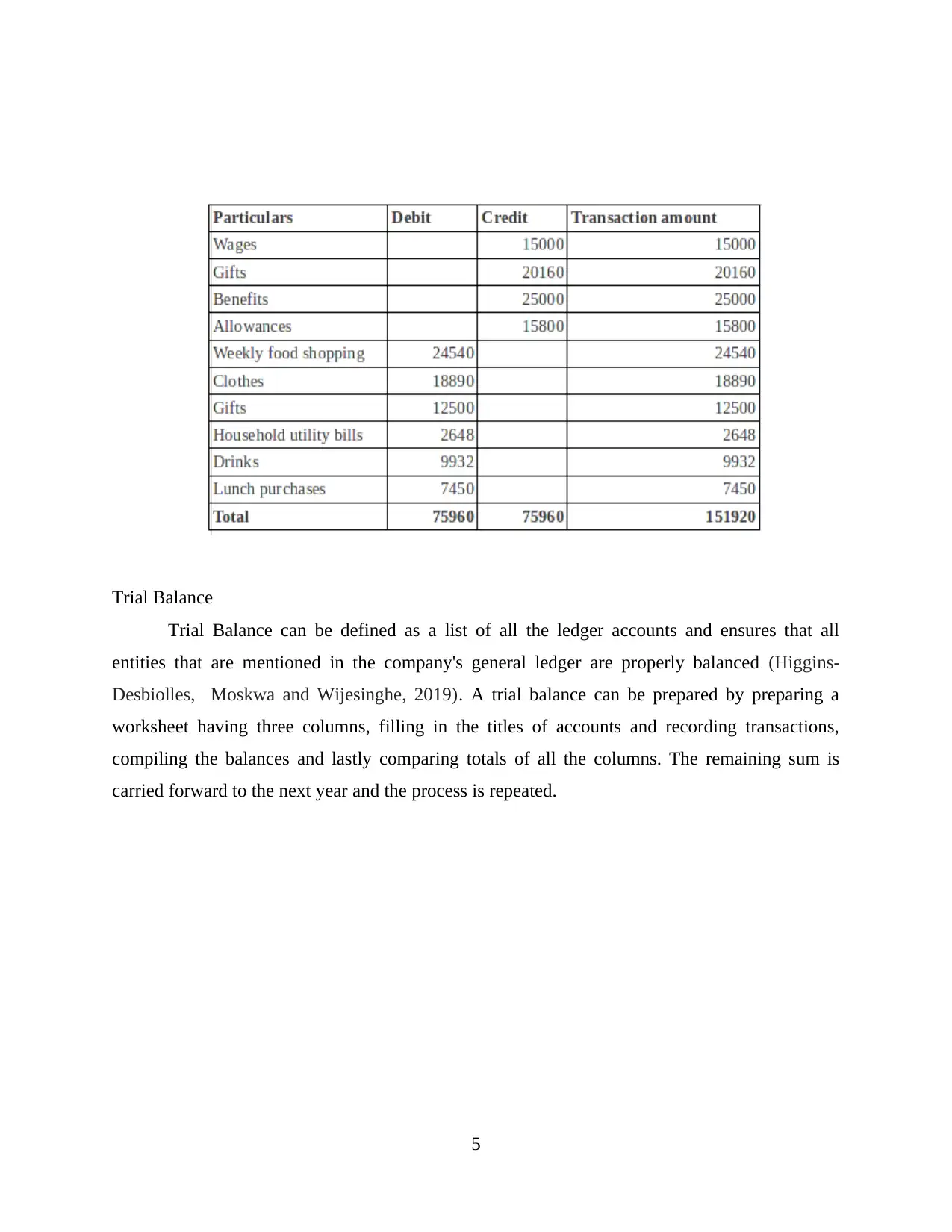
Trial Balance
Trial Balance can be defined as a list of all the ledger accounts and ensures that all
entities that are mentioned in the company's general ledger are properly balanced (Higgins-
Desbiolles, Moskwa and Wijesinghe, 2019). A trial balance can be prepared by preparing a
worksheet having three columns, filling in the titles of accounts and recording transactions,
compiling the balances and lastly comparing totals of all the columns. The remaining sum is
carried forward to the next year and the process is repeated.
5
Trial Balance can be defined as a list of all the ledger accounts and ensures that all
entities that are mentioned in the company's general ledger are properly balanced (Higgins-
Desbiolles, Moskwa and Wijesinghe, 2019). A trial balance can be prepared by preparing a
worksheet having three columns, filling in the titles of accounts and recording transactions,
compiling the balances and lastly comparing totals of all the columns. The remaining sum is
carried forward to the next year and the process is repeated.
5

Types of costs
Variable cost – This bis the cost that is associated with variable inputs that are used in
production and change with a variation in the volume of production (Hsu and Stanworth,
2018).
Fixed cost – This is the cost of fixed inputs or raw materials that are used in the
production process and do not vary with any change in the volume of products produced.
Calculation of profit margin
PER UNIT TOTAL
£ £ £ £
SALES 60 800000
COST OF PRODUCTION
DM 10 190000
DL 20 380000
VOH 5 95000
FOH 5 95000
6
Variable cost – This bis the cost that is associated with variable inputs that are used in
production and change with a variation in the volume of production (Hsu and Stanworth,
2018).
Fixed cost – This is the cost of fixed inputs or raw materials that are used in the
production process and do not vary with any change in the volume of products produced.
Calculation of profit margin
PER UNIT TOTAL
£ £ £ £
SALES 60 800000
COST OF PRODUCTION
DM 10 190000
DL 20 380000
VOH 5 95000
FOH 5 95000
6
⊘ This is a preview!⊘
Do you want full access?
Subscribe today to unlock all pages.

Trusted by 1+ million students worldwide
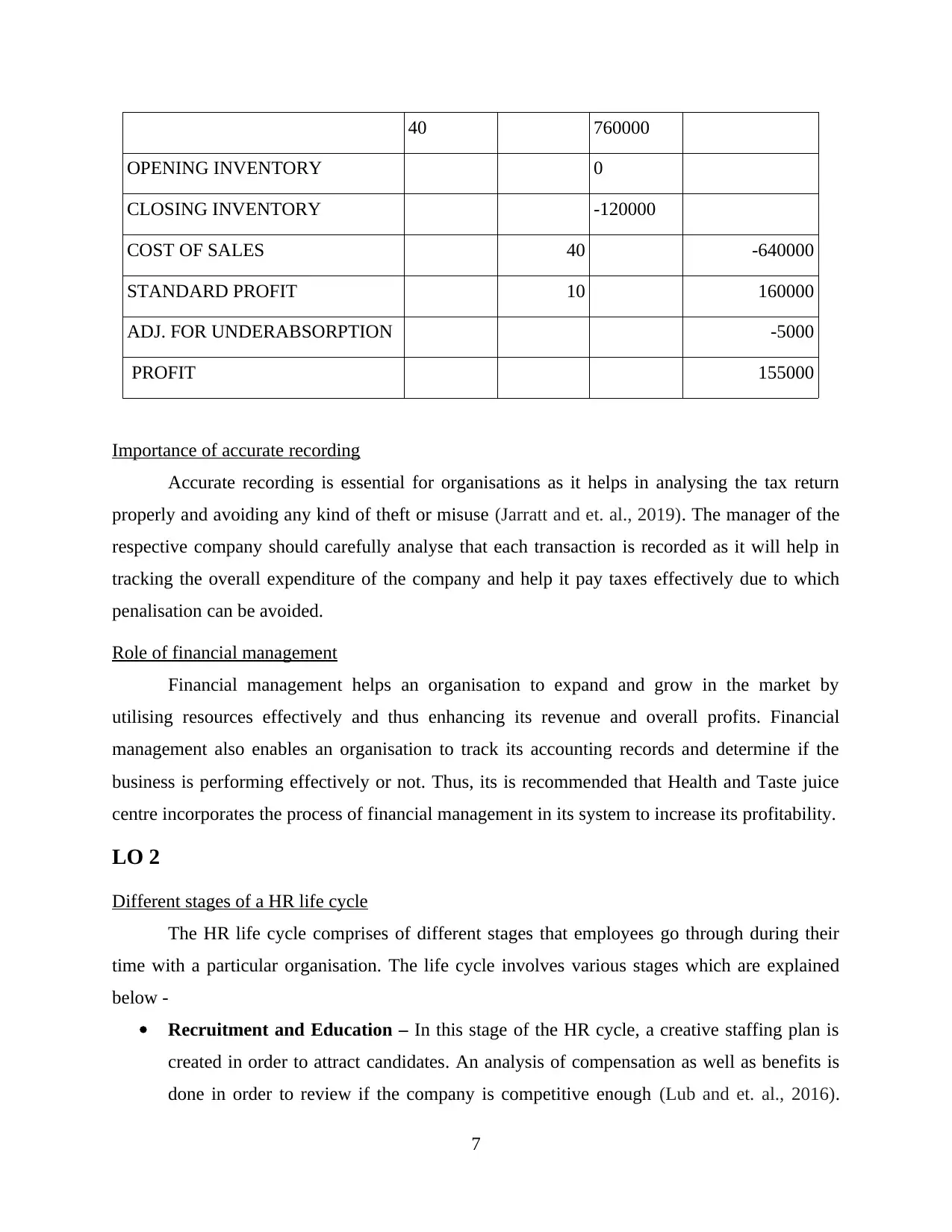
40 760000
OPENING INVENTORY 0
CLOSING INVENTORY -120000
COST OF SALES 40 -640000
STANDARD PROFIT 10 160000
ADJ. FOR UNDERABSORPTION -5000
PROFIT 155000
Importance of accurate recording
Accurate recording is essential for organisations as it helps in analysing the tax return
properly and avoiding any kind of theft or misuse (Jarratt and et. al., 2019). The manager of the
respective company should carefully analyse that each transaction is recorded as it will help in
tracking the overall expenditure of the company and help it pay taxes effectively due to which
penalisation can be avoided.
Role of financial management
Financial management helps an organisation to expand and grow in the market by
utilising resources effectively and thus enhancing its revenue and overall profits. Financial
management also enables an organisation to track its accounting records and determine if the
business is performing effectively or not. Thus, its is recommended that Health and Taste juice
centre incorporates the process of financial management in its system to increase its profitability.
LO 2
Different stages of a HR life cycle
The HR life cycle comprises of different stages that employees go through during their
time with a particular organisation. The life cycle involves various stages which are explained
below -
Recruitment and Education – In this stage of the HR cycle, a creative staffing plan is
created in order to attract candidates. An analysis of compensation as well as benefits is
done in order to review if the company is competitive enough (Lub and et. al., 2016).
7
OPENING INVENTORY 0
CLOSING INVENTORY -120000
COST OF SALES 40 -640000
STANDARD PROFIT 10 160000
ADJ. FOR UNDERABSORPTION -5000
PROFIT 155000
Importance of accurate recording
Accurate recording is essential for organisations as it helps in analysing the tax return
properly and avoiding any kind of theft or misuse (Jarratt and et. al., 2019). The manager of the
respective company should carefully analyse that each transaction is recorded as it will help in
tracking the overall expenditure of the company and help it pay taxes effectively due to which
penalisation can be avoided.
Role of financial management
Financial management helps an organisation to expand and grow in the market by
utilising resources effectively and thus enhancing its revenue and overall profits. Financial
management also enables an organisation to track its accounting records and determine if the
business is performing effectively or not. Thus, its is recommended that Health and Taste juice
centre incorporates the process of financial management in its system to increase its profitability.
LO 2
Different stages of a HR life cycle
The HR life cycle comprises of different stages that employees go through during their
time with a particular organisation. The life cycle involves various stages which are explained
below -
Recruitment and Education – In this stage of the HR cycle, a creative staffing plan is
created in order to attract candidates. An analysis of compensation as well as benefits is
done in order to review if the company is competitive enough (Lub and et. al., 2016).
7
Paraphrase This Document
Need a fresh take? Get an instant paraphrase of this document with our AI Paraphraser
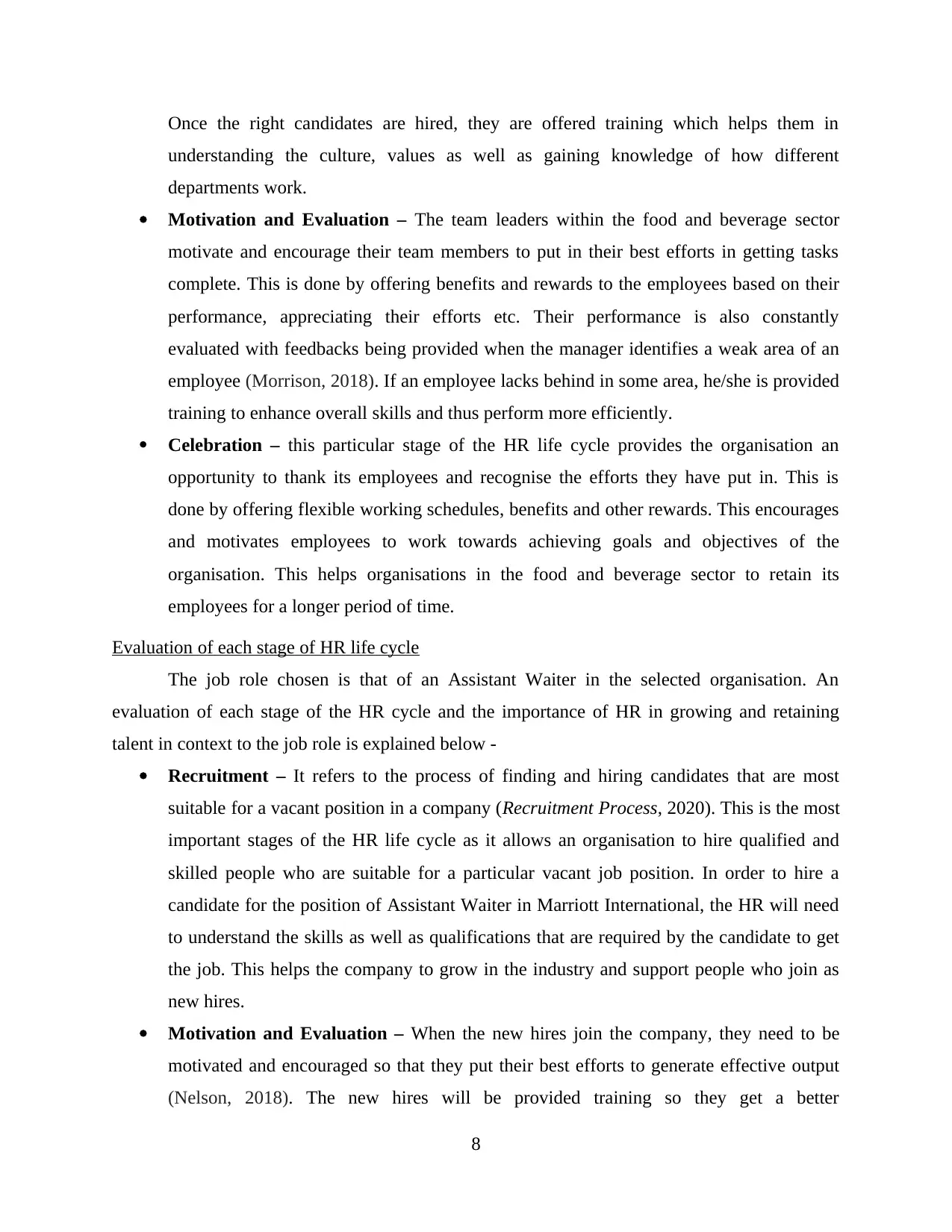
Once the right candidates are hired, they are offered training which helps them in
understanding the culture, values as well as gaining knowledge of how different
departments work.
Motivation and Evaluation – The team leaders within the food and beverage sector
motivate and encourage their team members to put in their best efforts in getting tasks
complete. This is done by offering benefits and rewards to the employees based on their
performance, appreciating their efforts etc. Their performance is also constantly
evaluated with feedbacks being provided when the manager identifies a weak area of an
employee (Morrison, 2018). If an employee lacks behind in some area, he/she is provided
training to enhance overall skills and thus perform more efficiently.
Celebration – this particular stage of the HR life cycle provides the organisation an
opportunity to thank its employees and recognise the efforts they have put in. This is
done by offering flexible working schedules, benefits and other rewards. This encourages
and motivates employees to work towards achieving goals and objectives of the
organisation. This helps organisations in the food and beverage sector to retain its
employees for a longer period of time.
Evaluation of each stage of HR life cycle
The job role chosen is that of an Assistant Waiter in the selected organisation. An
evaluation of each stage of the HR cycle and the importance of HR in growing and retaining
talent in context to the job role is explained below -
Recruitment – It refers to the process of finding and hiring candidates that are most
suitable for a vacant position in a company (Recruitment Process, 2020). This is the most
important stages of the HR life cycle as it allows an organisation to hire qualified and
skilled people who are suitable for a particular vacant job position. In order to hire a
candidate for the position of Assistant Waiter in Marriott International, the HR will need
to understand the skills as well as qualifications that are required by the candidate to get
the job. This helps the company to grow in the industry and support people who join as
new hires.
Motivation and Evaluation – When the new hires join the company, they need to be
motivated and encouraged so that they put their best efforts to generate effective output
(Nelson, 2018). The new hires will be provided training so they get a better
8
understanding the culture, values as well as gaining knowledge of how different
departments work.
Motivation and Evaluation – The team leaders within the food and beverage sector
motivate and encourage their team members to put in their best efforts in getting tasks
complete. This is done by offering benefits and rewards to the employees based on their
performance, appreciating their efforts etc. Their performance is also constantly
evaluated with feedbacks being provided when the manager identifies a weak area of an
employee (Morrison, 2018). If an employee lacks behind in some area, he/she is provided
training to enhance overall skills and thus perform more efficiently.
Celebration – this particular stage of the HR life cycle provides the organisation an
opportunity to thank its employees and recognise the efforts they have put in. This is
done by offering flexible working schedules, benefits and other rewards. This encourages
and motivates employees to work towards achieving goals and objectives of the
organisation. This helps organisations in the food and beverage sector to retain its
employees for a longer period of time.
Evaluation of each stage of HR life cycle
The job role chosen is that of an Assistant Waiter in the selected organisation. An
evaluation of each stage of the HR cycle and the importance of HR in growing and retaining
talent in context to the job role is explained below -
Recruitment – It refers to the process of finding and hiring candidates that are most
suitable for a vacant position in a company (Recruitment Process, 2020). This is the most
important stages of the HR life cycle as it allows an organisation to hire qualified and
skilled people who are suitable for a particular vacant job position. In order to hire a
candidate for the position of Assistant Waiter in Marriott International, the HR will need
to understand the skills as well as qualifications that are required by the candidate to get
the job. This helps the company to grow in the industry and support people who join as
new hires.
Motivation and Evaluation – When the new hires join the company, they need to be
motivated and encouraged so that they put their best efforts to generate effective output
(Nelson, 2018). The new hires will be provided training so they get a better
8
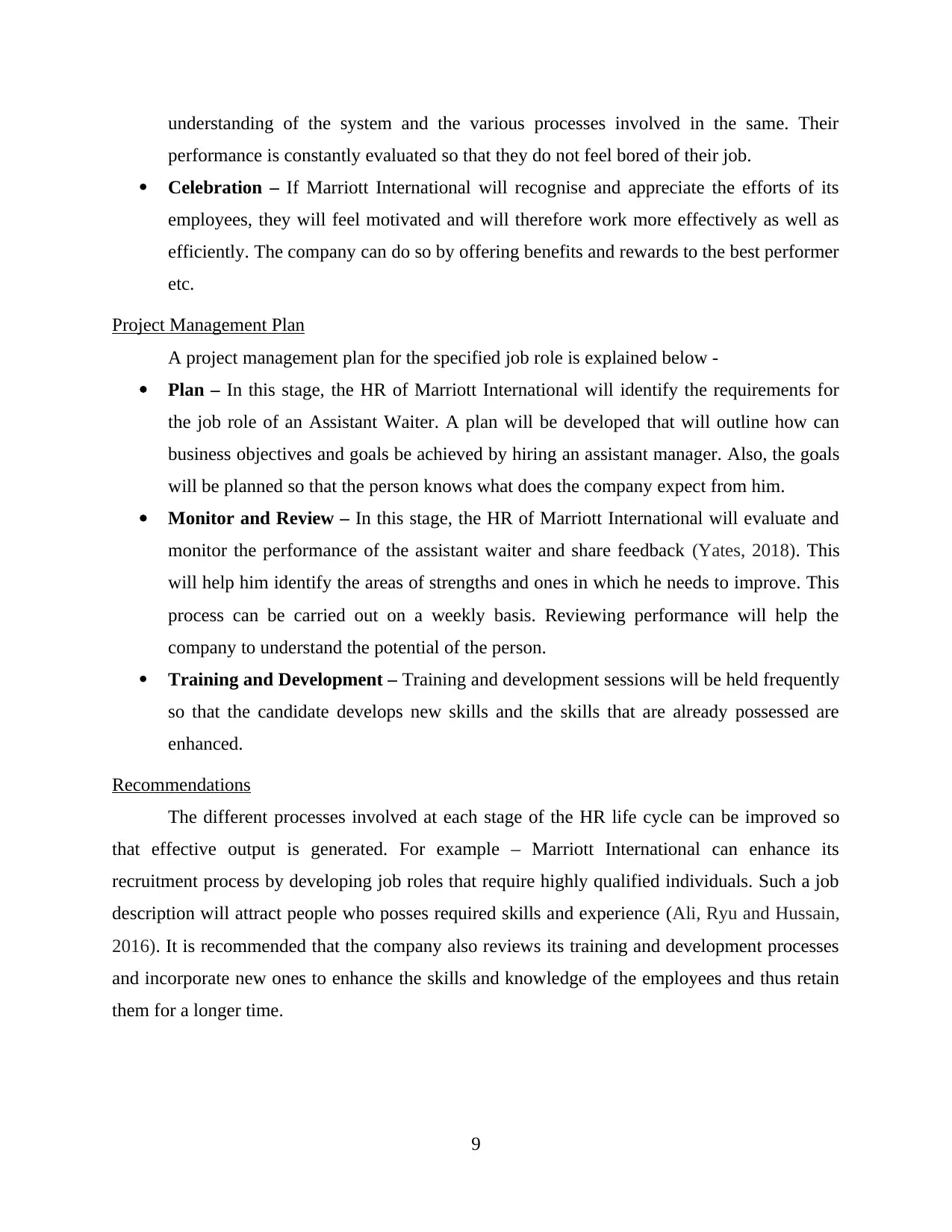
understanding of the system and the various processes involved in the same. Their
performance is constantly evaluated so that they do not feel bored of their job.
Celebration – If Marriott International will recognise and appreciate the efforts of its
employees, they will feel motivated and will therefore work more effectively as well as
efficiently. The company can do so by offering benefits and rewards to the best performer
etc.
Project Management Plan
A project management plan for the specified job role is explained below -
Plan – In this stage, the HR of Marriott International will identify the requirements for
the job role of an Assistant Waiter. A plan will be developed that will outline how can
business objectives and goals be achieved by hiring an assistant manager. Also, the goals
will be planned so that the person knows what does the company expect from him.
Monitor and Review – In this stage, the HR of Marriott International will evaluate and
monitor the performance of the assistant waiter and share feedback (Yates, 2018). This
will help him identify the areas of strengths and ones in which he needs to improve. This
process can be carried out on a weekly basis. Reviewing performance will help the
company to understand the potential of the person.
Training and Development – Training and development sessions will be held frequently
so that the candidate develops new skills and the skills that are already possessed are
enhanced.
Recommendations
The different processes involved at each stage of the HR life cycle can be improved so
that effective output is generated. For example – Marriott International can enhance its
recruitment process by developing job roles that require highly qualified individuals. Such a job
description will attract people who posses required skills and experience (Ali, Ryu and Hussain,
2016). It is recommended that the company also reviews its training and development processes
and incorporate new ones to enhance the skills and knowledge of the employees and thus retain
them for a longer time.
9
performance is constantly evaluated so that they do not feel bored of their job.
Celebration – If Marriott International will recognise and appreciate the efforts of its
employees, they will feel motivated and will therefore work more effectively as well as
efficiently. The company can do so by offering benefits and rewards to the best performer
etc.
Project Management Plan
A project management plan for the specified job role is explained below -
Plan – In this stage, the HR of Marriott International will identify the requirements for
the job role of an Assistant Waiter. A plan will be developed that will outline how can
business objectives and goals be achieved by hiring an assistant manager. Also, the goals
will be planned so that the person knows what does the company expect from him.
Monitor and Review – In this stage, the HR of Marriott International will evaluate and
monitor the performance of the assistant waiter and share feedback (Yates, 2018). This
will help him identify the areas of strengths and ones in which he needs to improve. This
process can be carried out on a weekly basis. Reviewing performance will help the
company to understand the potential of the person.
Training and Development – Training and development sessions will be held frequently
so that the candidate develops new skills and the skills that are already possessed are
enhanced.
Recommendations
The different processes involved at each stage of the HR life cycle can be improved so
that effective output is generated. For example – Marriott International can enhance its
recruitment process by developing job roles that require highly qualified individuals. Such a job
description will attract people who posses required skills and experience (Ali, Ryu and Hussain,
2016). It is recommended that the company also reviews its training and development processes
and incorporate new ones to enhance the skills and knowledge of the employees and thus retain
them for a longer time.
9
⊘ This is a preview!⊘
Do you want full access?
Subscribe today to unlock all pages.

Trusted by 1+ million students worldwide
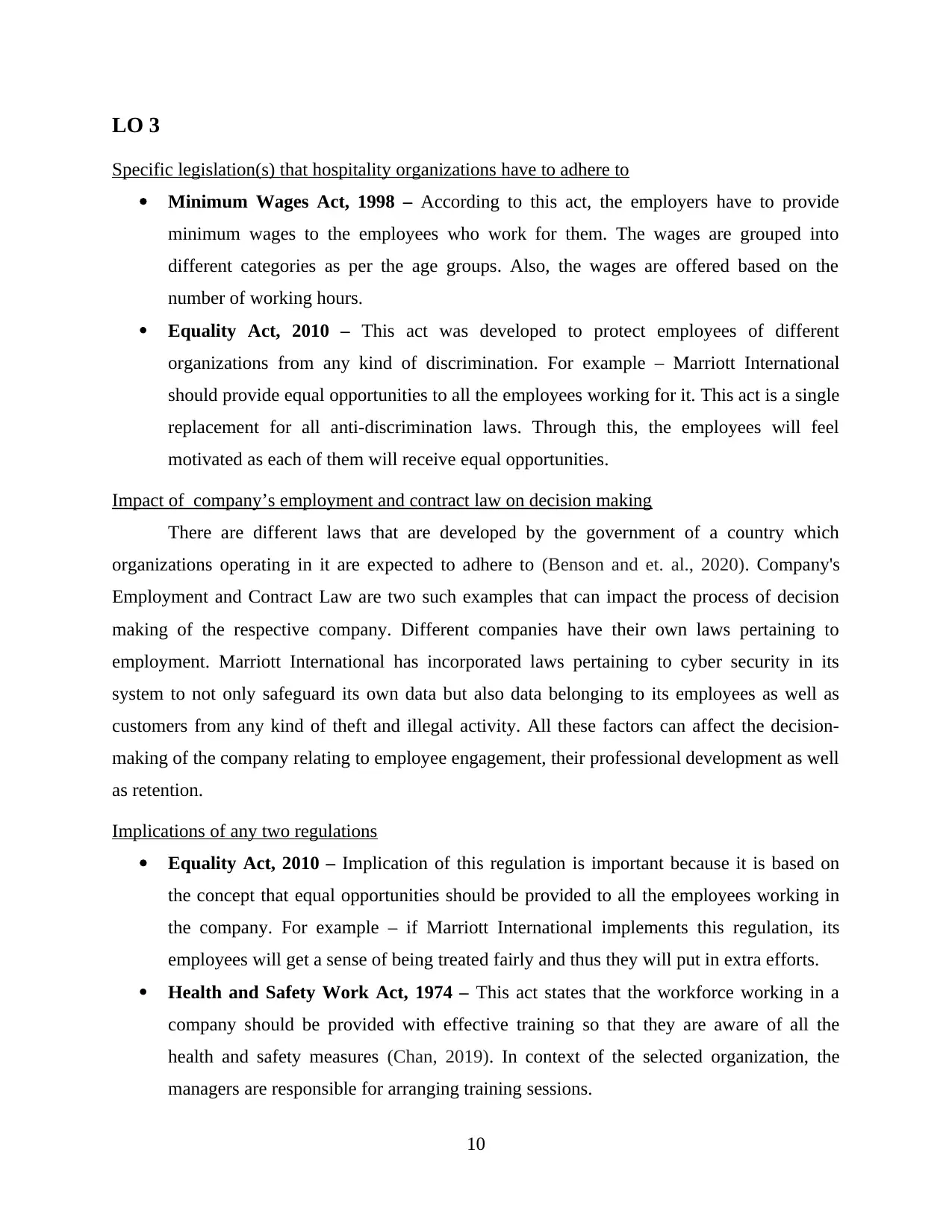
LO 3
Specific legislation(s) that hospitality organizations have to adhere to
Minimum Wages Act, 1998 – According to this act, the employers have to provide
minimum wages to the employees who work for them. The wages are grouped into
different categories as per the age groups. Also, the wages are offered based on the
number of working hours.
Equality Act, 2010 – This act was developed to protect employees of different
organizations from any kind of discrimination. For example – Marriott International
should provide equal opportunities to all the employees working for it. This act is a single
replacement for all anti-discrimination laws. Through this, the employees will feel
motivated as each of them will receive equal opportunities.
Impact of company’s employment and contract law on decision making
There are different laws that are developed by the government of a country which
organizations operating in it are expected to adhere to (Benson and et. al., 2020). Company's
Employment and Contract Law are two such examples that can impact the process of decision
making of the respective company. Different companies have their own laws pertaining to
employment. Marriott International has incorporated laws pertaining to cyber security in its
system to not only safeguard its own data but also data belonging to its employees as well as
customers from any kind of theft and illegal activity. All these factors can affect the decision-
making of the company relating to employee engagement, their professional development as well
as retention.
Implications of any two regulations
Equality Act, 2010 – Implication of this regulation is important because it is based on
the concept that equal opportunities should be provided to all the employees working in
the company. For example – if Marriott International implements this regulation, its
employees will get a sense of being treated fairly and thus they will put in extra efforts.
Health and Safety Work Act, 1974 – This act states that the workforce working in a
company should be provided with effective training so that they are aware of all the
health and safety measures (Chan, 2019). In context of the selected organization, the
managers are responsible for arranging training sessions.
10
Specific legislation(s) that hospitality organizations have to adhere to
Minimum Wages Act, 1998 – According to this act, the employers have to provide
minimum wages to the employees who work for them. The wages are grouped into
different categories as per the age groups. Also, the wages are offered based on the
number of working hours.
Equality Act, 2010 – This act was developed to protect employees of different
organizations from any kind of discrimination. For example – Marriott International
should provide equal opportunities to all the employees working for it. This act is a single
replacement for all anti-discrimination laws. Through this, the employees will feel
motivated as each of them will receive equal opportunities.
Impact of company’s employment and contract law on decision making
There are different laws that are developed by the government of a country which
organizations operating in it are expected to adhere to (Benson and et. al., 2020). Company's
Employment and Contract Law are two such examples that can impact the process of decision
making of the respective company. Different companies have their own laws pertaining to
employment. Marriott International has incorporated laws pertaining to cyber security in its
system to not only safeguard its own data but also data belonging to its employees as well as
customers from any kind of theft and illegal activity. All these factors can affect the decision-
making of the company relating to employee engagement, their professional development as well
as retention.
Implications of any two regulations
Equality Act, 2010 – Implication of this regulation is important because it is based on
the concept that equal opportunities should be provided to all the employees working in
the company. For example – if Marriott International implements this regulation, its
employees will get a sense of being treated fairly and thus they will put in extra efforts.
Health and Safety Work Act, 1974 – This act states that the workforce working in a
company should be provided with effective training so that they are aware of all the
health and safety measures (Chan, 2019). In context of the selected organization, the
managers are responsible for arranging training sessions.
10
Paraphrase This Document
Need a fresh take? Get an instant paraphrase of this document with our AI Paraphraser
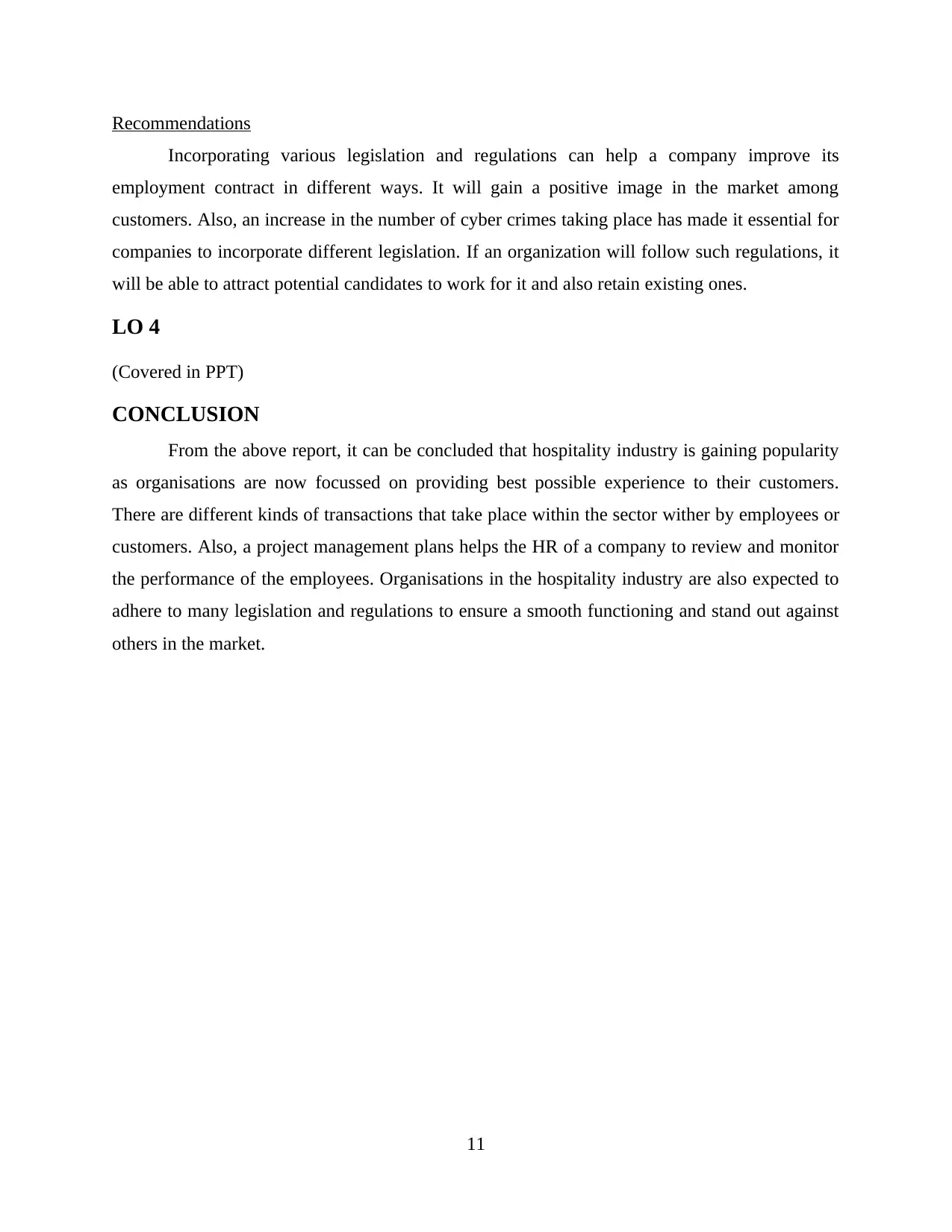
Recommendations
Incorporating various legislation and regulations can help a company improve its
employment contract in different ways. It will gain a positive image in the market among
customers. Also, an increase in the number of cyber crimes taking place has made it essential for
companies to incorporate different legislation. If an organization will follow such regulations, it
will be able to attract potential candidates to work for it and also retain existing ones.
LO 4
(Covered in PPT)
CONCLUSION
From the above report, it can be concluded that hospitality industry is gaining popularity
as organisations are now focussed on providing best possible experience to their customers.
There are different kinds of transactions that take place within the sector wither by employees or
customers. Also, a project management plans helps the HR of a company to review and monitor
the performance of the employees. Organisations in the hospitality industry are also expected to
adhere to many legislation and regulations to ensure a smooth functioning and stand out against
others in the market.
11
Incorporating various legislation and regulations can help a company improve its
employment contract in different ways. It will gain a positive image in the market among
customers. Also, an increase in the number of cyber crimes taking place has made it essential for
companies to incorporate different legislation. If an organization will follow such regulations, it
will be able to attract potential candidates to work for it and also retain existing ones.
LO 4
(Covered in PPT)
CONCLUSION
From the above report, it can be concluded that hospitality industry is gaining popularity
as organisations are now focussed on providing best possible experience to their customers.
There are different kinds of transactions that take place within the sector wither by employees or
customers. Also, a project management plans helps the HR of a company to review and monitor
the performance of the employees. Organisations in the hospitality industry are also expected to
adhere to many legislation and regulations to ensure a smooth functioning and stand out against
others in the market.
11
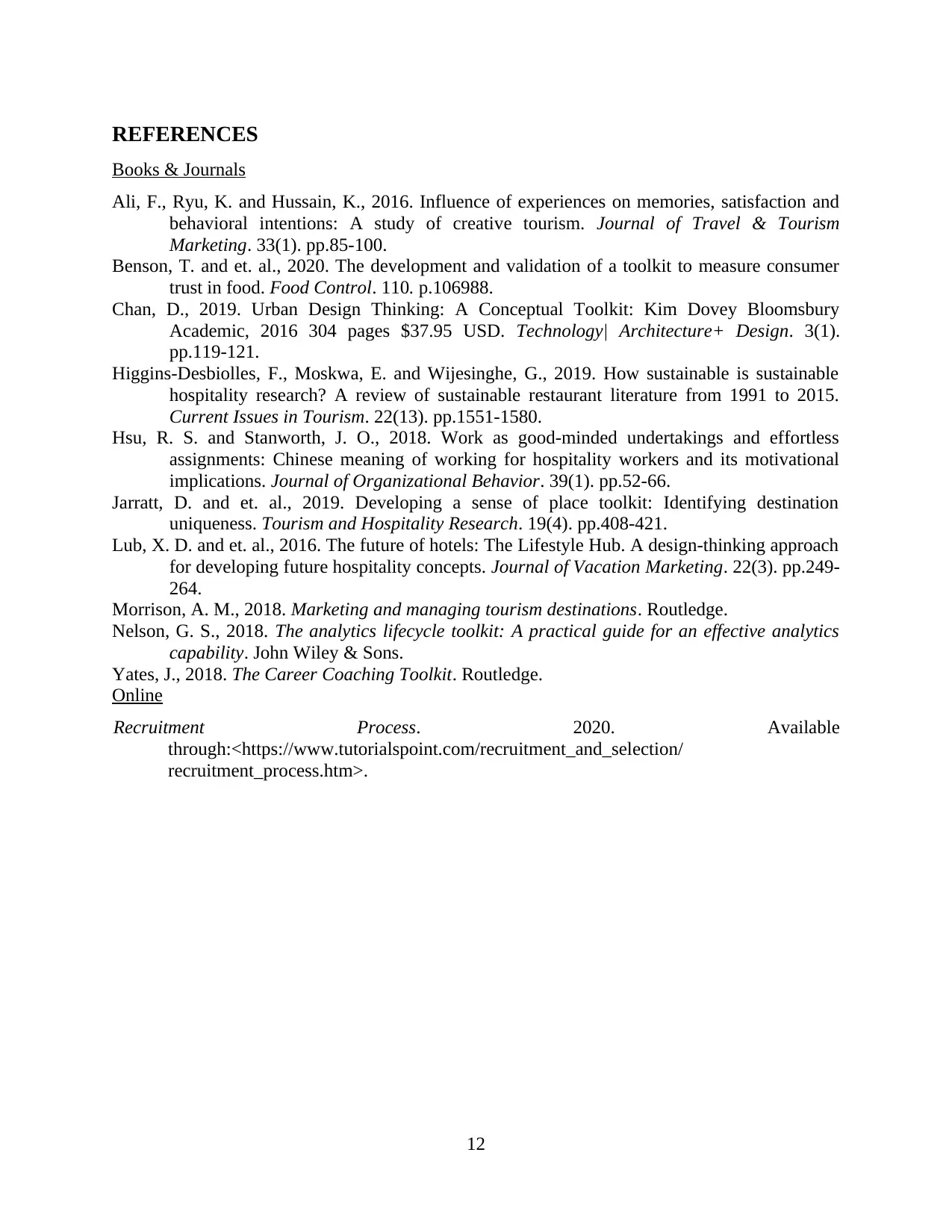
REFERENCES
Books & Journals
Ali, F., Ryu, K. and Hussain, K., 2016. Influence of experiences on memories, satisfaction and
behavioral intentions: A study of creative tourism. Journal of Travel & Tourism
Marketing. 33(1). pp.85-100.
Benson, T. and et. al., 2020. The development and validation of a toolkit to measure consumer
trust in food. Food Control. 110. p.106988.
Chan, D., 2019. Urban Design Thinking: A Conceptual Toolkit: Kim Dovey Bloomsbury
Academic, 2016 304 pages $37.95 USD. Technology| Architecture+ Design. 3(1).
pp.119-121.
Higgins-Desbiolles, F., Moskwa, E. and Wijesinghe, G., 2019. How sustainable is sustainable
hospitality research? A review of sustainable restaurant literature from 1991 to 2015.
Current Issues in Tourism. 22(13). pp.1551-1580.
Hsu, R. S. and Stanworth, J. O., 2018. Work as good‐minded undertakings and effortless
assignments: Chinese meaning of working for hospitality workers and its motivational
implications. Journal of Organizational Behavior. 39(1). pp.52-66.
Jarratt, D. and et. al., 2019. Developing a sense of place toolkit: Identifying destination
uniqueness. Tourism and Hospitality Research. 19(4). pp.408-421.
Lub, X. D. and et. al., 2016. The future of hotels: The Lifestyle Hub. A design-thinking approach
for developing future hospitality concepts. Journal of Vacation Marketing. 22(3). pp.249-
264.
Morrison, A. M., 2018. Marketing and managing tourism destinations. Routledge.
Nelson, G. S., 2018. The analytics lifecycle toolkit: A practical guide for an effective analytics
capability. John Wiley & Sons.
Yates, J., 2018. The Career Coaching Toolkit. Routledge.
Online
Recruitment Process. 2020. Available
through:<https://www.tutorialspoint.com/recruitment_and_selection/
recruitment_process.htm>.
12
Books & Journals
Ali, F., Ryu, K. and Hussain, K., 2016. Influence of experiences on memories, satisfaction and
behavioral intentions: A study of creative tourism. Journal of Travel & Tourism
Marketing. 33(1). pp.85-100.
Benson, T. and et. al., 2020. The development and validation of a toolkit to measure consumer
trust in food. Food Control. 110. p.106988.
Chan, D., 2019. Urban Design Thinking: A Conceptual Toolkit: Kim Dovey Bloomsbury
Academic, 2016 304 pages $37.95 USD. Technology| Architecture+ Design. 3(1).
pp.119-121.
Higgins-Desbiolles, F., Moskwa, E. and Wijesinghe, G., 2019. How sustainable is sustainable
hospitality research? A review of sustainable restaurant literature from 1991 to 2015.
Current Issues in Tourism. 22(13). pp.1551-1580.
Hsu, R. S. and Stanworth, J. O., 2018. Work as good‐minded undertakings and effortless
assignments: Chinese meaning of working for hospitality workers and its motivational
implications. Journal of Organizational Behavior. 39(1). pp.52-66.
Jarratt, D. and et. al., 2019. Developing a sense of place toolkit: Identifying destination
uniqueness. Tourism and Hospitality Research. 19(4). pp.408-421.
Lub, X. D. and et. al., 2016. The future of hotels: The Lifestyle Hub. A design-thinking approach
for developing future hospitality concepts. Journal of Vacation Marketing. 22(3). pp.249-
264.
Morrison, A. M., 2018. Marketing and managing tourism destinations. Routledge.
Nelson, G. S., 2018. The analytics lifecycle toolkit: A practical guide for an effective analytics
capability. John Wiley & Sons.
Yates, J., 2018. The Career Coaching Toolkit. Routledge.
Online
Recruitment Process. 2020. Available
through:<https://www.tutorialspoint.com/recruitment_and_selection/
recruitment_process.htm>.
12
⊘ This is a preview!⊘
Do you want full access?
Subscribe today to unlock all pages.

Trusted by 1+ million students worldwide
1 out of 12
Related Documents
Your All-in-One AI-Powered Toolkit for Academic Success.
+13062052269
info@desklib.com
Available 24*7 on WhatsApp / Email
![[object Object]](/_next/static/media/star-bottom.7253800d.svg)
Unlock your academic potential
Copyright © 2020–2025 A2Z Services. All Rights Reserved. Developed and managed by ZUCOL.





